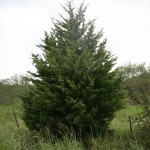Eastern Red Cedar, Eastern Redcedar
Juniperus virginiana L.
Cupressaceae (Cypress family)
Description
An evergreen tree, Eastern Red Cedar is a member of the Cypress family. It is an aggressive invader that spreads mainly by seed. There is great diversity in the physical characteristics of this species across its range. Although variable, its shape tends to be like a Christmas tree. Depending on the site, Eastern Red Cedar generally reaches 18 to 26 ft or 5 to 8 m tall. Fully mature trees may reach 40 to 50 ft or 12 to 15 m tall. Its bark is light reddish brown and separates into long strips. Its foliage varies from gray-green, blue-green, or light to dark green, and is scale-like and fragrant. The small, purplish flowers are deciduous, occurring from March to May. The fruits ripen from September to December on female trees. The berry-like fruits are pale blue, smooth, and sweet to the taste. Each fruit typically contains one to four seeds. The forage value of Eastern Red Cedar is poor for livestock and fair for wildlife. The fruits are an important food source for many birds and small mammals including the Cedar Waxwing. It also provides nesting materials and shelter.Habitat
Eastern Red Cedar is the most widely dispersed conifer as it grows natively in 37 states, mostly in the eastern half of the United States. It also reaches some southern locations in Canada. It grows in all types of soils, from rocky hilltops to swamps. Native habitats include fence rows, edges of woodlands, prairies, plains, pasturelands, and savannahs. Eastern Red Cedar prefers deep, moist, and well-drained alluvial sites. It is resistant to extreme drought and temperatures.Images
Plant Characteristics
Seed Type: Fruit/Berry
Duration: Perennial
Stem Texture: Hairless/Smooth
Growth Habit: Shrub (Woody)
Season: Evergreen
Distribution
 : 01 - Pineywoods, 02 - Gulf Prairies and Marshes, 03 - Post Oak Savannah, 04 - Blackland Prairies, 07 - Edwards Plateau, 08 - Rolling Plains, 09 - High Plains
: 01 - Pineywoods, 02 - Gulf Prairies and Marshes, 03 - Post Oak Savannah, 04 - Blackland Prairies, 07 - Edwards Plateau, 08 - Rolling Plains, 09 - High Plains
Distributions
Distribution refers to the ecological region in Texas that a plant has been found. You can also view a clickable map.
Book: Brush and Weeds of Texas Rangelands (B-6208)
Collection: Brush and Weeds





